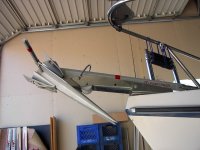Harvey-
The Delta was my first anchor and rode, and worked great everywhere I used it, but back then, I didn't have a windlass.
I bought the Fortress FX-16 at West Marine in Alameda, but wanted to wait until I got a windlass to use it, since it was so large dimensionally (only weighs 12 pounds).
Thus when I retired in 2000 and had the time, I added a Quick 500 windlass.
We had trouble with the windlass passing the rope/chain splice with the Delta Fast-Set anchor and rode. It wasn't a fault of that rode, but of the Quick Windlass, which choked on the standard type of splice (too large, not enough taper).
After considerable thought and experimentation, it seemed that the simple solution was to add 100 feet of chain (which the windlass passed flawlessly), develop my own rope/chain splice (smaller and more gradually tapered) add 250 feet of 1/2" 3-strand nylon rope, and add in the new Fortress anchor.
After some fine-tuning, I got the new set-up to work just fine. Even added an hand-held wired remote to pass up through the front hatch to operate the windlass from the deck when there were fouls (very rare, since mostly all I use is the first 100 feet of chain).
This left the Delta Fast-Set Anchor and Rode as surplus, so I offered it to the C-
Brat group, and you were the first to respond.
Joe. :teeth :thup

